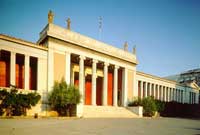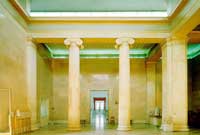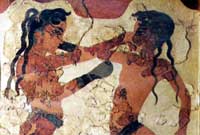 |
| It is the most important archaeological museum in Greece and one of the richest in the world concerning ancient Greek art. Its collections are
representative of all the cultures that flourished in Greece. The construction of the museum was begun in 1866 and completed in 1889 with the gradual addition of the west wing in 1874, of the north in 1881, of
the south in 1885 and finally, of the east wing. |
|
 |
|
| The building was erected in a large plot donated by Helen Tositsa, with the financial support of Demetrios and Nicolaos Vernardakis, the Archaeological Society and the Greek state. The
building of the museum was originally designed by the architect Ludwig Lange but his plans |
|
 |
|
were
partially modified by Panages Kalkos and later, by Harmodios Vlachos and
Ernst Ziller, who completely rearranged the facade and changed the plan
of the east wing and the central hall. Two additions were made on the
east side of the building; a new wing was constructed in the early 20th
century based on the plans of Anastasios Metaxas and a two-storeyed
building, designed by G. Nomikos, was erected in 1932-39. |
|
| The museum contains collections of :
- Prehistoric items
- Sculpture
- Pottery and Minor art
- Bronzes
- Egyptian Art |
|
 |
|
Other important activities:
Temporary
exhibitions
The National
Archeological Museum organizes and presents temporary
exhibitions, as well as participates in the presentation of temporary
exhibitions abroad. |
|
 |
|
Lectures on archaeological topics
Organized by the National
Archeological Museum and sponsored by the
Hellenic Ministry of Culture-ICOM and the Society of the Friends of the
National Museum.
Shop of the
Archaeological Receipts Fund
Guide-books, post-cards, slides, archaeological publications, posters,
casts, copies, maps, videotapes and toys are sold. |
|
Project TOMBA
The National Museum participates in the project TOMBA, an Internet image
data base, supported by the European Commission, with special reference
to burials of the Mycenaean period.
Educational Programs
Educational programs for students of Primary schools take place in the
halls of the museum, as part of the "Melina" Project, a joint
project of the Hellenic Ministries of Culture and Education. |
|
|
 |
|
|
|